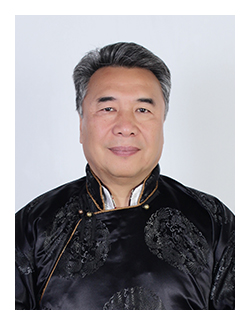Chewang Motup Goba, President’s speech during the AGM in 2020

Honourable Chief Guest Brig Ashok Abbey, other distinguished Guests, friends, colleagues and fellow explorers of the Himalaya.
Jullay and Welcome to the annual programme of the Himalayan Club.
It is good to see so many familiar faces in the room today for what I am sure is going to be an interesting and informative day; something so many of us have been looking forward to for such a long time. We climb and explore the mountains because they are there.
But we also bring back stories and lessons from our explorations, and that is what today is about.
Today, our special guests Joanna Croston, Steve Long, Deborah Baker and Mandeep Singh Soin, all eminent people in their own fields will speak about their life’s experiences and subjects respective to their fields.
Before we begin, however, it is with gratitude that I would like to welcome and thank the Godrej group for their tremendous support not only for this Seminar but for all the Himalayan Club activities throughout the year which is made possible, thanks to them. Your support for the club, it’s mission and our work mean so much.
Thank you!
I would also like to thank Allied Safety Equipments Pvt Ltd, our co – sponsors for the Annual program.
I would first like to say a few words to you all about how I stand before you all with profound humility to accept the honour that you have bestowed upon me of leading the Himalayan Club.
As I stand before you all today, my first thoughts turn to our club’s illustrious founders including Sir Geoffrey Corbett, field Marshal Sir William Birdwood, Major Kenneth Mason, the Maharaja of Jubbal and so many other legendary figures.
Their vision to establish the club and publish the Himalayan Journal has resulted in a tradition and resource that we are so proud of today.
Along with the famous names of explorers and climbers attached to the early history of the Himalayan Club, my thoughts also turn to the less well-known early explorers of the Trans Himalaya.
I want to acknowledge men like Rasul Galwan, an early Ladakhi explorer whose spirit of adventure has inspired me and whose name is now associated with the little-known River in the Karakoram – Galwan Nallah close to the Aksai Chin.
How many of you know that as a porter for Sir Francis Younghusband, Galwan, the son of a daring highway robber would author a book – Servant of Sahibs!
I mention Galwan’s name, mainly to say that the Shikaris of Ladakh as they were known those days, like the Sherpas of Darjeeling, Nepal and the Bhotias of Kumaon, played a critical role in the early explorations of the Trans Himalaya.
As I accept this honour to become President of the Himalayan Club, I would like to honour all these people for their role in the early explorations of the Himalaya and Karakoram mountains.
I also want to say that your decision to make me President of the Himalayan Club speaks volumes about the journey and evolution of the Himalayan Club, where someone like me – from my background – can lead this organization.
When the Himalayan Club was founded in 1928, its mission statement said the goal of the club was to encourage and assist Himalayan travel and exploration, and to extend knowledge of the Himalaya and adjoining mountain ranges through science, art, literature and sport.”
I believe that all of us present in this room can say that this mission has been executed with great pride and skill over the decades.
And I want to stress, that this good work continues today!
Through the pages of the Himalayan Journal, members of our club beginning with Sir Kenneth Mason have tracked, mapped and verified mountaineering expeditions across the Trans Himalaya.
This core activity of our club continued through the dedicated work of members such as Soli Mehta, Jagdish Nanavati, Harish Kapadia, and now Nandini Purandare.
What an incredible resource and record our Journal is.
The spirit of early exploration embodied by Sir Francis Younghusband continues today with members such as Divyesh Muni, Rajesh Gadgil and Vineeta who continue to explore and climb unnamed and unknown peaks across the Trans Himalaya.
The steady stewardship of our organization in its early days through the hard work of Sir Geoffrey Corbett and others has continued through current members such as Dr. M.S. Gill, Suman Dubey, Brig Ashok Abbey and Tanil Kilachand.
And please allow me to stress that I don’t simply want to single out the work of club members I named. I want to thank each member on the management committee, the local secretaries who represent the Himalayan club across the world and every one of you who puts in so many hours in all the activities of our club, to ensure that our club continues to thrive and grow.
With that, I would like to focus my remaining remarks with a few thoughts about the future.
The great work of the Himalayan Club includes not just its Journal, but also the recognition of the Tiger Sherpas and newer activities such as fundraising for the families of the support climbers who have died on the mountains.
It includes our work to support the rehabilitation of affected people in the Himalayan region due to cloudbursts like in Ladakh in 2010, and the earthquake in Nepal in 2015.
It is about the recognition we give to all the people who make our expeditions safe and successful through creating award like Garud Medal in memory of our late president Jagdish Nanavati.
All this good work must continue.
I believe, however, that we need what we already do today so well and much more in the years ahead.
Our beloved mountains are under siege today through the ravages of climate change, the clearest indication being the disappearing glaciers we see with our own eyes.
As a young boy of 7 years in September 1972, I remember crossing the Khardungla pass for the first time. When I think back to that time, I remember clearly that the whole north face used to be covered by glaciers and snow.
Today those glaciers have all but disappeared!
In 1986 when I visited Siachen on an expedition to Sia Kangri it used to take about 40 minutes to get onto the glaciers from the snout of the glacier.
When I got a chance to visit the Siachen again after a gap of about 16 years, I was horrified to see that the whole stretches up to Camp III which is 3 days walk had turned into moraine. The speed with which these glaciers are receding and vanishing, and it is threatening the very existence of all living beings on this planet is a huge concern and a symbol of the fundamental challenges we have to address.
The significance of this cannot be overstated!
More than 1.6 billion people are sustained by Himalayan rivers that start in these disappearing glaciers.
For thousands of years, these mountains have been our spiritual homes while at the same time nurturing and providing rich natural resources and a home to diverse cultural and ethnic groups.
At the same time, the number of people who head to the mountains for recreational trekking and mountaineering or just to enjoy the flora and fauna is increasing every day.
We must understand that this is having a profound impact not just on the mountains themselves but also the communities that live in the mountains.
It is my belief that, building on the good work of the past, the Himalayan Club including its chapters across the country, must broaden the conversation beyond mountaineering.
We need to be the voice that articulates and sounds the alarm about the environmental pressures facing the mountains and mountain communities.
Even as climate change threatens our glaciers, it is also making trekking and climbing more and more riskier through avalanches, rockfalls, landslides and cloudbursts.
Unpredictable weather is making what we and so many others enjoy doing, more dangerous.
The Himalayan Club needs to be a leader in ensuring safety on the mountain through standards such as the training of guides through reputable organizations such as the UIAA.
Our UIAA program must be scaled up if we are to ensure that the increasing number of people who visit mountains do so in a safe manner.
We need to ensure that we never forget the impact mountaineering and visitors to the mountains have on the communities they pass through.
Climate change and increasing recreational trekking, mountaineering and other activities is having a profound impact on mountain communities.
We have a social responsibility to improve local economies in a responsible and sustainable manner.
We need to facilitate and train the youth of the Himalayan regions to be able to sustain themselves economically and environmentally through trekking, mountaineering and other naturalist activities.
We need to encourage waste reduction and make sure that leave no trace trekking, mountaineering and other recreational activities in the mountains is practiced by everyone.
It is my belief that the Himalayan Club, while focusing on its core activities, also has the will, the membership, the influence and history to lead on all three fronts.
One of my early goals as president is to invite you all, including representatives of Himalayan Club chapters across the country and the world to Ladakh next year where we can begin the conversation of how to address new and urgent challenges.
How this conversation will take place is something that I would like to discuss with each one of you.
I am really looking forward to your ideas and suggestions.
We have much to do, to grow and build on our history, as we approach the centenary of our club.
We must.
Let’s do it together!
Thank you and Jullay.



